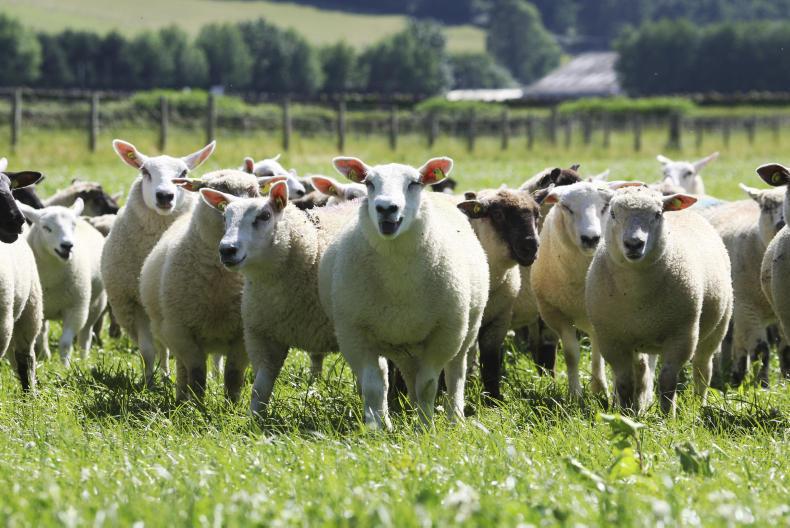Weaning is in full flow on farms that lambed in late February or early March. A high percentage of flocks that lambed from mid-March onwards are also approaching weaning over the next week to 10 days.
With markets in the latter half of the year variable in performance in recent years, it is important to have plans in place to market lambs in a way that works best for the farm. For some, this may be selling lambs as stores, or finishing lambs on a grass-based diet. For others, finishing plans will utilise forage crops or concentrate feeding.
Current state of play
It is worth assessing the current state of play and examining how lambs have performed from birth to weaning. A good ballpark target weaning weight for medium prolificacy lowland flocks is about 31kg to 32kg liveweight. This can fall back to 30kg in high prolificacy flocks and likewise increase above 32kg for flocks with a high percentage of single litters.
It is also useful to assess the range in weights, as this may have a direct influence on what plans you implement from here on. It is also good to use the experience of recent years, in particular your drafting pattern.
The general target for mid-season flocks finishing lambs in a grass-based system is in the region of 30% of lambs drafted by August, 50% by September, 70% to 80% by October and 90% by November.
Where these targets have not been achieved in recent years, leaving lambs and ewes competing for grass and difficulties in building autumn grass supplies, then making tweaks to your system will deliver significant benefits.
Grassland management
Grass quality has the potential to hold at a positive level from June to August, before seasonally declining as normal in September/October. Lamb performance will be closely influenced by pre and post-grazing sward heights and the length of time sheep spend grazing in swards.
Post-grazing sward heights increase as the season progresses, rising to 5cm- 6cm in rotational grazing systems in June and July and higher in set stocking systems
The recommended pre-grazing sward height is 7cm to 9cm. Post-grazing sward heights increase as the season progresses, rising to 5cm- 6cm in rotational grazing systems in June and July and higher in set stocking systems.
The exception to this is with after grass or lush leafy swards that are grazed in a paddock size that affords regular moves. The target lamb performance during this period should be upwards of 200g per day.
Supplementary feeding
Where performance from grass only is poor and significant quantities of concentrates are required late in the season to finish lambs, then there may be merit in introducing supplementary feeding earlier.
A good approach in this regard is to batch lambs close to finishing weights for feeding and let lighter lambs develop on grass. This approach also works well in terms of finishing lambs on forage crops.
The best response will be achieved by feeding a low level of supplementation, averaging in the region of 300g to 500g daily, depending on grass quality.
The higher allocation should be confined early in the season to ram lambs and care should be taken with fat covers for ewe and wether lambs.
Selling stores
The store trade is starting positively, with demand in recent years coming earlier in the season. It is again worth assessing which lambs are best to trade – light lambs, which may remain on the farm in the long term, or heavier lambs close to finishing. In all cases, a simple finishing budget will work well. (see management notes for more).
Pre-empting market demand
The second half of the year is generally a much trickier affair in terms of forecasting how markets are likely to perform. There are many external factors that can also have an effect.
For example, protests by the Beef Plan Movement at factory gates in the latter half of 2019 prevented processing for a sustained period in two factories and interrupted normal processing in another. The backlog that developed came at a time when UK sheep farmers were pushing higher numbers onto the market due to Brexit concerns and added to market pressures.
In the week preceding Eid al-Adha, throughput was recorded at 66,960 head, while in 2018, throughput was recorded at a substantial figure of 78,428 head
The one certainty for the trade in recent years is a spike in demand for Eid al-Adha. The Islamic holiday has underpinned the largest weekly kills in recent years. This included 2019, despite disruption at factory gates. In the week preceding Eid al-Adha, throughput was recorded at 66,960 head, while in 2018, throughput was recorded at a substantial figure of 78,428 head, followed by throughput of 72,400 in the week of the holiday.
As reflected in Figure 1, it is important to note that Eid al-Adha moves forward each year, due to differences between the Georgian calendar and the Islamic calendar.

This is also the same situation for Ramadan and farmers need to be aware of this when planning lambing and finishing dates.
Eid al-Adha is celebrated from the evening of Thursday 30 July to Monday 3 August. Ramadan begins on 12 April 2021 and finishes on 11 May 2021.
Live exports
The number of sheep exported live for Eid al-Adha has varied greatly in recent years. The trade is influenced by prices in the domestic market and key export markets, and in turn, the potential for live exporters to operate and generate a margin.
The trade in 2019 was also curtailed somewhat by soaring temperatures restricting animal transport. There are positive soundings from the trade, with some exporters already taking enquiries from producers and planning to put together suitable lots. The best demand is for ram lambs, preferably with long tails.






 This is a subscriber-only article
This is a subscriber-only article










SHARING OPTIONS: